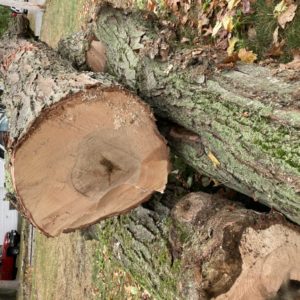We had a storm a couple weeks back that knocked out power for over 24 hours, and I think in response people are cutting down trees. Here is one of my neighbors. As a newbie to “the industry”, what happens to this? I would think in order of cost (lowest to highest), it would go:
1. Landfill
2. Mulch
3. Firewood
4. Lumber
Do tree-cutting companies have relationships with sawmills? How much usable lumber would a good sawmill get out of something like this top log (I think I can see some decently wide and thick boards), and how long would it take before it was usable?
These are just curiosity questions, I have no designs of my own (although I have a huge pine that a neighbor has been giving me the stink eye about for years).
neal
















Replies
There are urban sawmills that have relationships with everyone from tree services to municipalities. I've been to a guy in NJ that allows tree services to deposit qualifying trunk sections on his property to avoid disposal costs. I don't think he'll accept anything less than 24" diameter logs though.
Time to dry outdoors covered starts with the "1 year per inch" rule, but usually takes longer when you go over 2".
Not all individual trees are worth the time and effort to save and process for limber (definitely not pine). Around here yard trees get chopped up and fed to the grinder at the street. Chunks too big to grind go to the city's yard waste dump where they are turned into mulch. We have an urban sawmill that specializes in yard trees that are usually donated by owners, but it has to be a desirable (i.e., sellable) species. Most places wont take yard trees because they are more likely to have blade damaging nails, wire, or other metal imbedded in them. People who lose a tree and cut it up themselves, often leave the logs curbside and someone will come along and pick up for firewood.
Sometimes after a storm, I'll go cruising around and pick up some pieces that people have left out, looking for something worth milling. But generally the logs are too small (short) to make it worth the effort to process. Limbs are not really good as they will twist and dry funny. If you're a turner, it can be more worthwhile to pick up green wood.
Yard trees are most suitable for turning. It's rare to see decent lumber come from one, and it is almost never worth the cost or trouble.
Around here, every tree I've see cut down, up to 15-18 inches in diameter, goes right into the chipper. It's pretty awesome to see something that big get atomized,
I get most of my turning stock from trees that have been taken down in my neighborhood. I drive around and pick-up off cuts from tree cutters before they take it away to make firewood. This had me to meet those arborist that know their wood and after they cut down a tree and bring it to their yard, separate it in firewood, stacks of live edge 8/4 and turning stock such as burls and forks. I am now turning the blanks that I roughed out a year ago into finished bowls and will soon visit them to buy some green stock to replenish my blank inventory.
I don't know where you live but here in SE Pennsylvania we have a wealth of local saw mills. For wood of small worth(scrub maple, small poplar, etc) it gets ground up or fire wood. Red oak generally gets sent to fire wood. Walnut, beech, white oak that don't have alot of twist and are large generally get milled. Smaller branches are ground or cut for fire wood.
Tree services generally run on a pretty low margin and are competitive. Any way they can make some extra cash they will. There are some beautiful examples of 50 to 100 year old logs coming out of people's front yards. Dan
This forum post is now archived. Commenting has been disabled